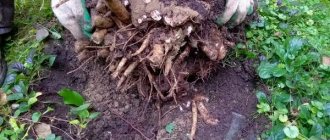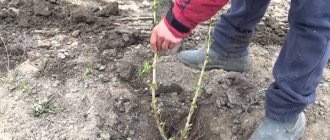When can grapes be replanted?
There are no universal dates when it is better to replant grapes. The gardener needs to focus on his region and specific climatic conditions.
The optimal time for planting and replanting is considered to be autumn and spring. In autumn, work begins after leaf fall and continues until frost. In the southern regions, where the soil does not freeze in winter, it is permissible to plant during prolonged thaws in January-February.
In spring, wait until the soil thaws. It is important to have time to transplant before the eyes begin to bloom. In spring, the soil is well saturated with moisture, which plants use for their development.
Important! The earlier the bushes are planted (subject to favorable conditions), the better they will take root.
When deciding how to properly replant grapes without loss to the harvest, the gardener must take into account not only the time of the operation, but also the age of the plant.
Reasons for moving to a new location
The need for transplantation arises in several cases.
We list the most common reasons:
- the initial location was chosen poorly - the grapes do not have enough sunlight, space for full growth, or they interfere with the growth of neighboring crops;
- the bush does not bear fruit;
- the planting plan on the site has changed;
- the time has come to plant young seedlings growing too close to each other;
- moving the vineyard to another site.
Grapes tolerate transplants well and quickly take root in a new place, so both young plants and adult bushes are replanted.
Methods for transplanting adult grape bushes of different ages
The first three years of life of a young plant are considered a seedling. During this period, it is actively forming roots. With age, the old roots thicken, the vital potential of the grapes and its ability to regenerate decreases. This means that the older the plant, the worse it takes root in a new place. Nevertheless, even mature bushes 7-10 years old are capable of producing good yields after transplantation.
How to transplant an adult grape bush:
- with a lump of earth;
- with an open root system.
For adult bushes, the first method is optimal - with a lump of earth and an intact root system. However, this is not always possible without special equipment.
So, depending on the type of soil and climate, the root system of a grape bush penetrates to the following depth:
- in a humid, cool climate - 20-40 cm;
- in the south - 40-120 cm;
- on sandy soils - 1.5-3.5 m;
- on rocks in the southern regions - 3-5 m or more.
Thus, the task of the winegrower when replanting is to preserve as many roots as possible. The older the plant, the larger the earthen lump will be.
Preparatory work
We recommend reading our other articles
- Caring for raspberries in summer
- Strawberry variety San Andreas
- Varieties of zucchini for open ground
- Nipple drinkers for rabbits
Before transplanting grapes, it is worth carrying out preparatory work. The place for planting grapes is always chosen to be sunny, so that the light falls on the bush and warms it up well. At the same time, the place must be protected from wind and drafts on at least one side. If there are other bushes and trees on the site, they should be at a distance of 2-4 meters from the grapes.
The planting hole is made at least 1 month before planting the bush
Important!
The grapes have a developed root system. A site for it is chosen with a low groundwater level (at least 2 meters), otherwise the roots of an adult bush may begin to rot.
The planting hole is made at least 1 month before planting the bush. It is dug a meter deep and 60-80 cm wide, depending on the size of the seedling. Drainage is placed at the bottom if the soil is dense, heavy and does not allow water to pass through well. You can use broken brick, expanded clay or pebbles as drainage. Planting soil is mixed from soil obtained by digging a hole, humus, wood ash, superphosphate and potassium sulfate. The components are mixed and left for a month.
You should purchase a seedling from a specialized store or grow it yourself from a cutting. A young bush should have a developed root system, a growth of 35 cm. Before planting, 1-2 buds are cut off from the bush. The cuts are lubricated with garden varnish so that the bush does not start to hurt. Bare roots are shortened to 30 cm, diseased and damaged ones are simply cut off. You can soak the root system in a growth stimulator for 12-24 hours, then it will take root faster in a new place.
One-year-olds, two-year-olds, three-year-olds
Young seedlings are planted from the school to a permanent place at the age of 1-3 years. They can be either with a closed root system or with an open one.
In specialized literature on viticulture, it is advised to do the following:
- Select 1-2 most developed shoots on the seedling, remove the rest.
- Trim the selected shoots, leaving 2-3 eyes on each.
- Remove all roots located above the first or second node from the heel. This should stimulate the development of the primary heel roots.
- Shorten the heel roots to 20-25 cm when planting in holes and to 5-7 cm under a hydraulic drill.
Features of the grape root system
The development of the lower, hidden underground part of the seedling and adult plant depends on the characteristics of the variety, its age, nutrition, and the location of aquifers. There are 2 stages of root growth: until approximately mid-summer (July) and from autumn (September), until falling asleep. When the earth warms up to 17-21 °C (third decade of June), the rate of formation of the root system reaches its climax. The roots begin to grow before the buds hatch (or at the beginning of the process).
Further, the growing season and the formation of foliage are accompanied by the simultaneous strengthening of the underground part and branching of the roots. If the plant has enough moisture and microelements in the soil, then in September the 2nd stage of growth begins, which ends when the temperature of the root layers drops to 8 °C.
Drought significantly affects the development of grapes: in this case, root growth is limited to one stage. The main factor restraining and determining the development of the lower part of the plant is moisture. This is the difference between grapes grown in the Moscow region and Rostov: in the first case, the seedling will grow, gradually slowing down, until the end of September, due to higher soil moisture. Exactly how the root system will be located and its type depends on the variety and growing conditions.
Generally speaking, there are 2 types:
- Intensive.
- Extensive.
In the first case, the roots are short, but branched, stretching along the aquifers. In the second, they are long and less developed laterally, sometimes reaching 3.5 meters (Cabernet and Sauvignon varieties in Crimea). In profile, the system has 1, 2 and 3 maximums: each of them is tied to specific growing conditions.
Features of transplanting grapes at different times of the year
When planning how to transplant grapes to another place in the fall or spring, the gardener proceeds from the climate of the region and the type of root system of the planting material (closed - ZKS or open - OKS).
Transplanting seedlings in autumn
When replanting in autumn, the undoubted advantage is that in the spring the bush begins to grow early and does not lag behind the rest in development. This means that in the first year after the operation you can get a small harvest.
If you plan to replant grapes from ZKS in the fall, be prepared that the plant will not have time to take root in the new place and will not survive the winter. To avoid this, you need to carefully mulch the soil around the seedling and make a more thorough shelter.
Alternatively, in areas with little snow in the winter and possible frosts, it is recommended to dig up seedlings with ZKS in the fall and plant them only in the spring, organizing a cool winter for them in the basement or cellar. Bushes with ACS are replanted in the fall.
Differences when transplanting in spring and summer
When replanting in spring, there is a possibility that the bush will take a long time to get used to the new conditions, will begin to grow late and, as a result, the vine will not have time to ripen. The harvest with this method of transplantation will have to wait longer.
Important! Planting vegetative grapes in unheated soil will most likely lead to the death of the root system, and therefore the entire bush.
An undoubted advantage of spring planting is that the hole for the plant is prepared well in advance, in the summer or autumn. During the winter months, all fillers added to the pit are compacted and create a more uniform soil.
In summer, replanting adult bushes is not advisable. During the growing season, the plant will spend a lot of energy restoring the roots to the detriment of the development of the above-ground part and may wither. Young vegetative seedlings with a closed root system, which can be transplanted without damaging the roots, are moved to a new location in the summer.
Benefits of spring transplantation
Spring transplantation of grapes has a number of advantages that make the work easier:
- Unlike autumn, when the air temperature can change dramatically, in spring it is easier to navigate the weather.
- Additives are easier to adapt to in a new place and have enough time to gain strength before the winter cold.
- The ability to prepare the planting site in advance, fertilize the soil, and give it a rest before spring work.
- Objectively determine how well the additive has taken root or died.
- Some grape varieties, after planting in spring, begin to bear fruit the following year. Seedlings transferred in the fall will produce a harvest only after two years.
Important to remember! Although spring is characterized by sunny days, you should not let your guard down, because frosts occur at night.
How to replant grapes
In general, the procedure for transplanting grapes to a new place does not differ from regular planting. Only one operation is added - excavation.
How to dig up bushes
The older the plant, the harder it is to dig it up with its entire root system. Procedure:
- Dig up the bush at a distance of about 50 cm from the trunk, being careful not to damage the roots of neighboring plants.
- Carefully expose the roots. If they go deep into the ground, cut them off. At this stage, the main thing is to preserve the heel and the main roots coming from it.
- If it is physically possible, grab the bush directly with a lump of earth and transfer it to a sheet of metal, tarpaulin or into a wheelbarrow, with the help of which they drag the plant to a new planting site.
- To prevent the lump from falling apart, you can wrap it in a piece of cloth and bandage it.
- If the bush is to be replanted with an open root, gently shake the soil on the roots with your hands or a stake, completely exposing them.
Beginning gardeners doubt whether they need to water the plant before replanting. Watering helps to ensure that the soil does not crumble and holds a lump. If you need to clean the roots, you do not need to water the bush first.
An interesting way to dig up a bush using a hydraulic drill:
- The soil around the bush is worked well with a hydraulic drill until it becomes slurry.
- Then all the slurry is scooped out, leaving the roots intact.
- If there is no hydraulic drill, the bush is dug up and watered until the soil is saturated.
Preparation of planting material
Before or after transplantation, regardless of the age of the bush, the above-ground part must be shortened. 2-3 annual shoots are left on the plant. They are cut 2-3 buds closer to the beginning of the sleeve. If you plan to renew the entire above-ground part, it is cut off at the black head.
Planting grapes in a new place
A new place for the bush is prepared in advance, at least a month in advance, or even better, six months in advance. The planting depth and its method depend on:
- climate,
- type of soil on the site,
- shelter options for the winter,
- snow depth and other factors.
Traditionally, in industrial vineyards, bushes are planted in holes or under a hydraulic drill. The latter method is only suitable for young seedlings with a shortened root system.
Recommended planting depth for industrial cultivation:
- in the European part - 45-50 cm;
- on irrigated fertile soils of Central Asia - 55-60 cm;
- on sandy soils - 60-65 cm.
However, in amateur viticulture in Russia, different regions have established their own methods:
- in the south, where the soil warms up well and dries out quickly, they are planted in large, pre-fertilized holes to a depth of 40-50 cm;
- in the Moscow region, the method of planting in raised ridges to a depth of 30-40 cm is gaining popularity;
- in northern viticulture zones, for example in the Urals, grapes are planted in trenches to provide the bushes with good shelter in winter and quick warming in summer.
In areas with poor soil (sand, stone), deep holes 1x1x1 m are made for planting, which are filled with plant residues, rotted manure or humus, and mineral fertilizers. There is no such need on black soils. There it is enough to dig a hole according to the size of the root system and plant the seedling to a depth of no more than 40-45 cm.
Thus, there is no universal planting scheme suitable for all regions. Each winegrower chooses for himself the one that suits the conditions of his site. When transplanting an adult bush, the same rules apply as during normal planting, which we will consider below.
Necessary preparation
First, we note that for safety reasons, as a rule, relatively young vines are replanted - no older than 5–6 years.
In order for the vine transplant to be successful, it is necessary to choose a free, well-lit and protected space from gusts of wind.
Transplanting grapes in the spring requires certain preparation in the fall: it is then that you need to dig a fairly deep hole for the grape bushes - the earthen clods should fit comfortably in it. Then you need to fertilize the soil using ash, complex minerals and humus (each hole will need from six to eight kg).
With the onset of spring, a new, smaller hole is dug for the rhizome next to the depression. If you are going to transplant several bushes, the holes you dig should be approximately 2 meters apart from each other.
Before transplanting grapes to a new area, the soil must be warmed with a hot solution of potassium permanganate.
Instructions for transplanting grapes
With a clod of earth and a rooter
Sequence of operations:
- The planting pit is prepared in proportion to the earthen coma.
- Pour a couple of buckets of water into it.
- Lower the bush into the hole and remove the wrapping fabric.
- The gaps between the earthen lump and the walls of the pit are gradually covered with earth, watering periodically.
- When the hole is completely covered with earth, form a circle around the trunk and once again water the bush abundantly with the addition of a root growth stimulator.
With open root system
Boarding order:
- Prepare a hole in advance 15-20 cm deep than the length of the underground trunk of the seedling and water it with water.
- 10-25 cm of fertile soil mixed with humus and mineral fertilizers is poured onto the bottom.
- Before planting, the roots of the seedling are trimmed to 25-30 cm and dipped in a creamy mash (1 part cow manure 2 parts clay).
- A mound is made in the center of the hole on which the seedling is placed.
- The roots are spread along the slopes of the mound.
- The hole with the seedling is filled halfway with soil and watered.
- Cover with soil up to surface level.
- Form a tree trunk circle and water it abundantly.
Important! In the area of covered viticulture, the base of the shoots after planting should be 1-2 cm below the soil level.
Preparing grapes for transplantation
Before digging up the grapes, the above-ground part is shortened. The long vine is removed. There remain two branches and two young vines on each with three buds. The tops of the remaining shoots are trimmed. The sections are treated with garden varnish, liquid wax or a special paint, which is used to protect against pests and diseases.
Two days before digging up the grapes, they are watered abundantly to the entire depth of the future coma so that it does not collapse. For young plants, the minimum diameter of the coma is 30 cm, for older plants it is at least 50 cm. A ring around the coma is dug so wide that two people can easily fit there.
A bunch of grapes before transplanting to a new place
The roots that protrude beyond the lump are carefully removed with pruning shears so that the soil does not crumble. To successfully transfer the coma to a new location, the side walls are wrapped with thick fabric and carefully tied. A flat support is placed under the bottom of the lump, for example a sheet of plywood, with which the lump is lifted to the surface. You need to do this together, holding the lump for support.
Tip #2. Some gardeners recommend wrapping the lump with a flexible metal sheet, such as corrugated sheeting, and moving another one under the bottom of the lump.
Mistakes when transplanting grapes
If the seedling does not take root and grows poorly, the peculiarities of transplanting adult grapes may not have been taken into account.
Common mistakes:
- Late planting in spring. The plant needs time to adapt to new conditions and restore its roots. In addition, in the spring the soil dries out quickly and a seedling with ACS may not have enough soil moisture to start growing.
- Early planting in spring. In cold soil, the roots of a vegetating seedling with SCD may die.
- Too much root pruning. Having lost the heel roots, an adult bush cannot restore them and receive adequate nutrition.
- Planting in a dry pit. The dry layer between the roots and soil moisture prevents the roots from starting to grow.
- An attempt to collect a full harvest in the year of transplantation. Excessive load on the bush leads to the fact that the plant wastes its own resources without receiving sufficient nutrition.
Why is a transplant needed?
Replanting a grapevine may be necessary in the following cases:
- Initially, the wrong site was chosen - lowland, lack of sunlight, drafts. Heavy soil unsuitable for vineyards.
- During the initial planting, the distance between the vines was not maintained; the bushes began to interfere with each other, intertwining with vines.
- The garden area needs redevelopment.
- A nearby crop interferes with the growth of the vine, and vice versa.
- The need arose to “move” the vineyard to another garden plot.
- Slow shoot growth.
- Low yield.
Caring for grapes after transplantation
In the first year after transplanting to a new location, the bush needs increased care and attention.
Caring for transplanted grapes
You must be prepared that the plant will not immediately recover and produce full harvests. The inflorescences that form in the first year are cut off completely so that the bush devotes all its energy to restoring the roots.
Watering
The bush is watered in the same way as the rest of the vineyard: by ground method or through a pipe. When choosing the second method, gardeners should take into account the depth of the root layer. For example, if the roots do not penetrate further than 40 cm, and the pipe is buried deeper into the ground, the bush does not receive water when watering.
Depending on soil moisture, 3-5 waterings are carried out per season, every 2 weeks in dry weather and 3-4 weeks in wet weather. For early varieties, watering is completed in mid-July, for late varieties - in mid-August.
Every 15-20 days after rain or watering, loosen the soil around the bush. This prevents the soil from drying out and promotes air flow to the roots.
Feeding
Fertilizers filled into the hole during planting are enough for the first 2 years. During this period, additional feeding is carried out if signs of a lack of elements are visible.
Frost protection
Bushes are prepared for winter in different ways, depending on the growing region:
- cover the ground with a mulch layer;
- spud;
- protect bushes with non-woven material;
- The seedlings are covered with soil.
Disease and pest control
During the season, several sprays are carried out with Bordeaux mixture against mildew. In general, the replanted bush is treated in the same way as the rest of the vineyard.
Important! It is advisable to use reduced doses of drugs on a weakened bush.
Choosing a transfer site
Transplanted grapes begin to bear fruit no earlier than in the second year after relocation
A new place for grapes must be chosen so that the bush does not interfere there. If he continues to “harass” his neighbors, there will be no point in replanting. Next, you should make sure that the grapes receive enough sunlight, otherwise a good harvest will not be expected. At the same time, the new place must be protected from strong winds, which can damage the bushes.
Preparatory stage
Viticulture cannot be rushed. It is better to prepare both the bush itself and the hole at the future planting site in advance.
A year or two before transplantation, they refuse catarrh (removal of the upper, so-called dew roots). By the way, in a number of viticulture schools, catarrhism is not practiced at all. While the vine is getting used to its new location, it will need all the roots - both deep and superficial.
To minimize stress, the root system is adapted in advance. When the harvest is harvested, the trunk is dug around a radius of about half a meter with a narrow groove. The older the bush, the deeper you will have to dig. Usually 60–80 cm is enough. The trench is filled with loose fertile soil and spilled to the full depth. Soon many young roots will form near the trunk. Such a lump is easily removed, and the transplanted vine is able to produce a harvest, albeit reduced by half.
Preliminary digging takes a lot of effort and time; it is used only for particularly valuable varieties. Or if the hand is not full enough. Experienced ones operate more simply: dug up - moved - planted.
In autumn, more intensive pruning is needed: after wintering, this bush will lose a significant part of its roots. Leave no more than two eyes on each sleeve and the same number on replacement shoots.
The size of the planting hole depends on the size of the root ball. It is somewhat more spacious, both in width and depth. They proceed from local conditions: in the south, the plant tends downward to the aquifers. Northern grapes are more willing to develop the upper, warmed horizons.
This is done for two reasons:
- So that the vine does not inherit diseases and pests from its predecessor.
- Every plant (and grapes) releases inhibitors into the soil, that is, substances that inhibit the roots of its relatives. They persist for some time after uprooting.
Fertile soil is used as is, poor soil is mixed with turf soil (1:1) and fertilizers. Approximate norm per plant:
- humus – 6 kg;
- superphosphate – 200 g;
- ammonium sulfate – 80 g;
- potassium salt – 35 g.
If necessary, drainage is placed in the hole - crushed stone, gravel, expanded clay, then a small layer of sand. The soil is distributed in such a way that the most nutritious part is at the bottom: the main share of feeding will be within the reach of the heel roots. The partially filled pit is covered on top with boards or roofing felt and left to “mature.”











